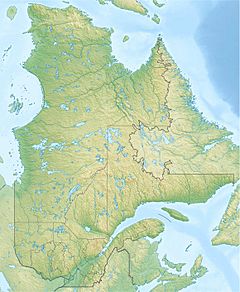Saint-Jean North-East River facts for kids
Quick facts for kids Saint-Jean North-East River |
|
|---|---|
| Other name(s) | Rivière Saint-Jean Nord-Est |
| Country | Canada |
| Province | Quebec |
| Region | Côte-Nord |
| RCM | Minganie |
| Physical characteristics | |
| Main source | Charpeney Lake Lac-Jérôme 541 units? |
| River mouth | Gulf of Saint Lawrence 0 metres (0 ft) 50°17′00″N 64°20′04″W / 50.283333°N 64.334444°W |
| Length | 70.4 kilometres (43.7 mi) |
| Basin features | |
| Progression | Saint-Jean River, Gulf of Saint Lawrence |
The Saint-Jean North-East River (also known as Rivière Saint-Jean Nord-Est in French) is a river in Quebec, Canada. It's like a smaller stream that flows into a bigger river. This river joins the Saint-Jean River from its north side. It flows through a wild area called Lac-Jérôme in the Minganie Regional County Municipality, which is part of the Côte-Nord region of Quebec.
Contents
Where Does the Saint-Jean North-East River Flow?
The Saint-Jean North-East River flows from the north towards the south. It is located between two other rivers. To its east are the Mingan River and the Mingan North-West River. To its west is the main Saint-Jean River.
The River's Starting Point
The Saint-Jean North-East River begins at a place called Charpeney Lake. This lake is quite long, about 6.7 km (4.2 mi), and sits high up in the mountains at an altitude of 541 m (1,775 ft). Charpeney Lake has two main parts. These parts are separated by a narrow passage called Kauapauakaht Pass.
Many smaller streams feed into Charpeney Lake. For example, water flows in from five streams coming from the east. Another stream comes from Fauteux Lake to the south.
The River's Journey Downstream
From Charpeney Lake, the Saint-Jean North-East River flows for about 70.4 km (43.7 mi). As it travels, the river drops about 490 m (1,610 ft) in height. This creates many interesting features along its path.
Upper Part of the River
In its upper section, the river flows north for about 4.7 km (2.9 mi). It goes through three different lakes. The first lake is 1.3 km (0.81 mi) long. The second lake is 2.8 km (1.7 mi) long. The third lake is 0.9 km (0.56 mi) long and even has an island in its middle.
After these lakes, the river continues for 3.5 km (2.2 mi). It flows north through a deep valley. It then turns east, crossing an area called Portage Kapapuanapestshepant. The river also widens into another lake here. This lake receives water from Lac des Caps.
Middle Part of the River
The middle section of the river stretches for about 20.5 km (12.7 mi). It first flows east, then turns south. Along this part, the river widens into three more bodies of water. These areas are like small lakes or wider parts of the river.
The river then flows southeast for about 7.8 km (4.8 mi). It goes through a deep valley and curves around a mountain. It also passes over several rapids. Further along, it flows south through another lake, which is 0.6 km (0.37 mi) long.
Continuing for 5.7 km (3.5 mi), the river flows southeast. It passes Mount Uhukanatshehu. Many small streams and lakes add water to the river in this section. It also goes over more rapids before meeting the Antan brook.
Another Middle Section
This part of the river is about 19.7 km (12.2 mi) long. It flows south through a deep valley. Many streams and lakes join the river here from both the west and the east.
The river then turns southwest for about 7.8 km (4.8 mi). It collects water from four streams on the west side. It also gets water from three lakes on the southeast side. The river forms a loop to the north in this area.
Finally, for 4.4 km (2.7 mi), it flows west and then southwest. It collects water from more small lakes and streams. It also goes through the Kakahtshekauh Rapids. The river forms another loop to the south before a small river joins it from the north.
Lower Part of the River
The last section of the river is about 22.0 km (13.7 mi) long. It flows south through a forest valley and then a deep valley. It passes by Kaiamehenant Cliff on its west side. More lakes and streams add water to the river here. It also passes a place called Uhukanatshehu.
For the next 6.7 km (4.2 mi), the river continues south. It forms a curve to the west and goes through a deep valley. It passes a spot called Elbow Kanatuapiaht. More streams, including the Uhtshisk stream, join the river.
The final 6.7 km (4.2 mi) of the river flows south. It forms a large loop around a mountain. It also crosses a series of rapids before reaching its end.
Where Does the River End?
The Saint-Jean North-East River flows into the main Saint-Jean River. This meeting point is located about 59.5 km (37.0 mi) northwest of Havre-Saint-Pierre village. It's also about 49.4 km (30.7 mi) north of where the main Saint-Jean River meets the ocean.
From this point, the water travels another 65.7 km (40.8 mi) down the Saint-Jean River. Eventually, it flows into the Gulf of Saint Lawrence, which is a large arm of the Atlantic Ocean. Specifically, it enters the Jacques Cartier Strait.
What's in a Name?
The name "Rivière Saint-Jean Nord-Est" was officially recognized on December 5, 1968. This was done by the Commission de toponymie du Québec, which is like a special group that names places in Quebec.
Related Places and Topics
- Minganie Regional County Municipality
- Lac-Jérôme, a wild area without a town
- Rivière-Saint-Jean, a nearby town
- Charpeney Lake, where the river starts
- Estuary of Saint Lawrence
- List of rivers of Quebec


